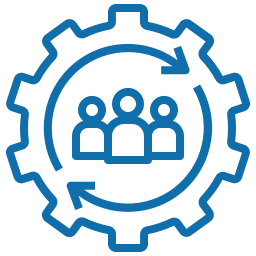






Human Resources
At Carolina PRG we look forward to being your career compass, we guide you toward opportunities that inspire and ignite your passion and purpose.
An HR professional is responsible for managing the entire employee lifecycle—from recruitment to retirement—while ensuring compliance with labor laws, fostering a positive work culture, and supporting the organization’s strategic goals.

Recruitment and Hiring
- Job Posting and Sourcing Candidates: HR professionals develop job descriptions and post vacancies on job boards, company websites, and social media platforms. They also source candidates through networking, recruitment agencies, and employee referrals.
- Screening and Interviewing: Reviewing resumes and applications to shortlist qualified candidates. They conduct initial phone screens or interviews to assess candidates’ fit with the role and company culture.
- Organizing Interviews: Coordinating interviews between candidates and hiring managers, ensuring the interview process is smooth and efficient.
- Selection and Offer Management: Working with the hiring team to select the best candidate, extending job offers, negotiating terms (salary, benefits), and ensuring all paperwork is in place.

Onboarding New Employees
- Orientation Programs: HR professionals design and conduct onboarding programs to help new employees integrate into the company, understand the culture, and become familiar with company policies, procedures, and benefits.
- Setting Up Workstations and Access: Coordinating with IT and facilities departments to ensure that new hires have all the necessary equipment, tools, and system access on their first day.
- New Hire Paperwork: Collecting and processing essential documents, such as contracts, tax forms, benefits enrollment, and background checks.



Employee Relations
- Conflict Resolution: HR professionals mediate conflicts between employees or between employees and management. They work to resolve disputes professionally and fairly, promoting a positive work environment.
- Employee Feedback: Conducting employee satisfaction surveys, stay interviews, and exit interviews to gather feedback on employee morale, engagement, and suggestions for improvement.
- Performance Improvement: Addressing performance-related issues by providing coaching, developing improvement plans, or conducting disciplinary actions if necessary.
- Policy Enforcement: Ensuring that all employees adhere to company policies, handling violations and grievances, and maintaining a consistent and fair approach to discipline.

Compensation and Benefits Management
- Salary and Wage Administration: HR professionals manage the company’s compensation structure, ensuring that wages are competitive, equitable, and compliant with industry standards and labor laws.
- Benefits Programs: Administering employee benefits programs, such as health insurance, retirement plans (401k), paid time off, and wellness initiatives. They handle benefits enrollment, claims, and employee inquiries.
- Payroll Coordination: Ensuring accurate and timely payroll processing, including tracking employee hours, overtime, bonuses, deductions, and taxes.
- Compensation Analysis: Conduct market research to evaluate salary trends and ensure that the company’s compensation strategy remains competitive and aligned with organizational goals.

Training and Development
- Identifying Training Needs: Assessing the skill gaps and development needs of employees through performance reviews, feedback, and organizational goals.
- Creating Training Programs: Developing and delivering training programs or coordinating with external trainers to enhance employee skills, leadership abilities, and professional growth.
- Career Development: Assisting employees with career path planning, providing coaching, and offering mentorship programs to support long-term employee growth and retention.
- Tracking Training Progress: Monitoring the completion of training programs and ensuring that employees meet required certifications or continuing education credits.

Performance Management
- Performance Reviews: Organizing and overseeing the company’s performance appraisal process. This includes setting performance goals, facilitating feedback from managers and peers, and ensuring fair assessments.
- Employee Recognition: Implementing employee recognition programs to reward and acknowledge high-performing employees or teams, boosting motivation and job satisfaction.
- Goal Setting and Monitoring: Working with management to establish clear performance goals for employees and ensuring regular follow-ups to track progress.



Compliance and Legal Responsibilities
- Employment Law Compliance: Ensuring the company complies with all federal, state, and local employment laws and regulations, such as equal employment opportunity (EEO), wage and hour laws, anti-discrimination laws, and health and safety regulations.
- Record Keeping: Maintaining accurate and secure employee records, such as contracts, performance reviews, disciplinary actions, and benefits information, to comply with legal and company requirements.
- Workplace Safety (OSHA): Ensuring the organization follows workplace safety regulations (e.g., OSHA compliance), conducting safety training, and reporting workplace injuries or incidents as required.
- Handling Disciplinary Actions: Following due process when dealing with employee violations, ensuring that actions are consistent with company policies and that documentation is thorough to mitigate legal risks.

Employee Engagement and Retention
- Building Employee Engagement Programs: Developing programs to enhance employee engagement, satisfaction, and retention. This can include team-building activities, wellness programs, and initiatives to improve work-life balance.
- Promoting Work-Life Balance: HR professionals often implement policies such as flexible working hours, remote work options, or wellness initiatives to improve employee satisfaction and retention.
- Exit Interviews and Turnover Analysis: Conduct exit interviews with departing employees to gather feedback on why they’re leaving and use this data to address potential issues that could improve employee retention.

Human Resources Strategy and Planning
- Workforce Planning: Working closely with leadership to ensure that the company’s workforce is aligned with its long-term goals. This includes succession planning, talent acquisition, and workforce optimization.
- Organizational Development: Developing and implementing strategies to improve company culture, organizational structure, and employee productivity.
- Change Management: Supporting leadership during organizational changes, such as mergers, acquisitions, or restructuring, and ensuring smooth transitions by managing employee communications and addressing concerns.

Human Resources Information Systems (HRIS) Management
- Managing HR Systems: Using HRIS software to manage employee data, payroll, benefits, and other HR functions. Common systems include Workday, SAP SuccessFactors, ADP, and BambooHR.
- Reporting and Analytics: Generating reports and analyzing HR metrics such as turnover rates, employee satisfaction scores, time-to-hire, and diversity statistics to support decision-making and strategic planning.



Diversity and Inclusion Initiatives
- Promoting Diversity: Implementing initiatives that foster diversity, equity, and inclusion (DEI) in the workplace, ensuring fair hiring practices, diverse representation, and a culture of belonging.
- Training on Inclusion: Conducting training programs on topics such as unconscious bias, inclusive leadership, and cultural awareness to promote an inclusive work environment.
- Diversity Metrics: Monitoring and analyzing diversity-related metrics and using the data to develop initiatives to improve workplace diversity.

Employee Wellness and Mental Health Support
- Mental Health Programs: Coordinating with external providers to offer employee assistance programs (EAPs) that provide mental health support, counseling, and resources for managing stress.
- Wellness Initiatives: Implementing programs that support employee well-being, such as fitness challenges, mindfulness training, or nutrition seminars.

Labor Relations (in Unionized Environments)
- Union Negotiations: If the company has unionized employees, HR professionals may be involved in negotiating collective bargaining agreements, resolving disputes, and ensuring compliance with union contracts.
- Handling Grievances: Addressing grievances from unionized employees and working with union representatives to resolve issues in a manner that satisfies both the employees and the company.

Skills and Tools Commonly Used by HR Professionals:
- Interpersonal and Communication Skills: Ability to communicate clearly and effectively with employees, managers, and external parties.
- Problem-Solving and Conflict Resolution: Strong skills in mediating conflicts, resolving issues, and finding fair solutions.
- HR Software: Proficiency in using HR information systems (HRIS) such as Workday, SAP, ADP, or BambooHR to manage employee data, payroll, and benefits.
- Legal Knowledge: Understanding of employment law, compliance requirements, and labor regulations.
- Organization and Time Management: Strong organizational skills to manage multiple tasks, meet deadlines, and perform all HR functions efficiently.
- Empathy and Emotional Intelligence: The ability to connect with employees, understand their concerns and create an environment where they feel valued and heard.

Our Vision
At Carolina PRG, we aim to shape a future for Charlotte area professionals where every career move is a meaningful step forward, built on shared values and lasting partnerships.
Our Mission is to create remarkable career moments you are inspired to share with others.
Reach out to us today to find your ideal career!
